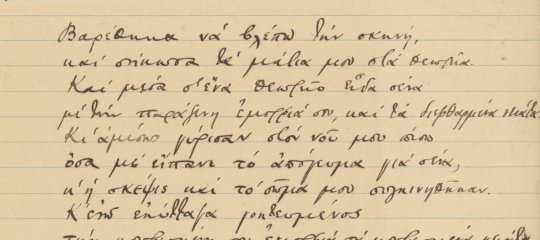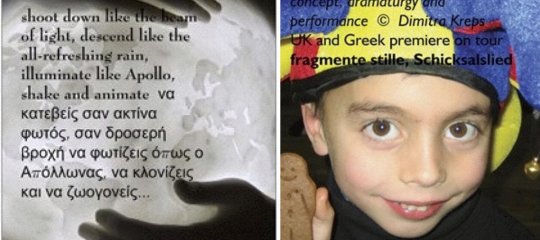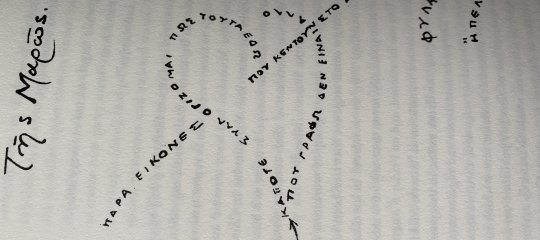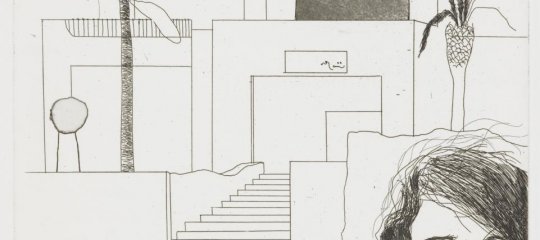Φεστιβάλ Αρχαιολογικών Ταινιών
DimitraMitta writes, "Αγαπητοί φίλοι,
Επειδή κάποιοι από εσάς δείξατε ενδιαφέρον για το Φεστιβάλ Αρχαιολογικών ταινιών, σας στέλνω:
1. Ένα κείμενο με τα αποτελέσματα του Αγώνα.
2. Σε συνημμένο αρχείο θα σας στείλω το συνολικό πρόγραμμα, ώστε να δείτε τις θεματικές.
3. Μερικές ηλεκτρονικές διευθύνσεις για απευθείας ενημέρωση.
4. Τον τρόπο με τον οποίο μπορούν οι ταινίες αυτές να έλθουν στα χέρια σας και να τις αξιοποιήσετε.
Φιλικά
Δήμητρα Μήττα"
4 Δεκεμβρίου 2006
 -1-
-1-
Μια άλλη ματιά
Τα βραβεία της 6ης Διεθνούς Συνάντησης Αρχαιολογικής Ταινίας
Θεσσαλονίκη
Άγνωστες αρχαιολογικές αποκαλύψεις, εντυπωσιακά ευρήματα της ιστορίας, αμφισβητούμενους ανά την ιστορία «μύθους» και αλήθειες, αλλά και τη διαχρονική δράση των αρχαιοκάπηλων και των κυκλωμάτων τους ανά τον κόσμο έφεραν στην οθόνη του «Ολύμπιον» της Θεσσαλονίκης οι 44 συνολικά αρχαιολογικές ταινίες που μετείχαν στην 6η Διεθνή Συνάντηση Αρχαιολογικής Ταινίας του μεσογειακού χώρου που ολοκληρώθηκε το βράδυ της Κυριακής.
Τη Διεθνή Συνάντηση διοργάνωσε για 6η φορά (και πρώτη στη Θεσσαλονίκη) το περιοδικό «Αρχαιολογία και Τέχνες», σε συνεργασία φέτος με το Διεθνές Φεστιβάλ Κινηματογράφου Θεσσαλονίκης.
Βραβευμένες έφυγαν από τη Θεσσαλονίκη η μια στις τρεις διαγωνιζόμενες ταινίες, καθώς τα βραβεία -που συνοδεύονται από χρηματικό έπαθλο 3.000 ευρώ το καθένα- έλαβαν οι εννέα από τις 27 ταινίες που μετείχαν στο διαγωνιστικό τμήμα της συνάντησης (από τις 28 Νοεμβρίου προβλήθηκαν συνολικά 44 ταινίες).
Τα βραβεία
Βραβείο σκηνοθεσίας έλαβε η ταινία του Γάλλου Ζαν Λικ Μπουβρέ «Κόα, ο ποταμός με τα χιλιάδες προϊστορικά χαρακτικά». Η ταινία καταγράφει τα προϊστορικά χαρακτικά που αποκαλύφθηκαν στις όχθες του ποταμού Κόα στην Πορτογαλία χάρη στη μείωση της στάθμης του, με αποτέλεσμα μια «επανάσταση» στη μελέτη της προϊστορίας.
«Κνωσός, ο λαβύρινθος των μύθων», είναι ο τίτλος της ταινίας του Νίκου Νταγιαντά (Ελλάδα) που απέσπασε το βραβείο σεναρίου με το σκεπτικό πως «παρουσιάζει την υποκειμενικότητα της αρχαιολογικής ματιάς και τον αναστοχασμό για το ρόλο που παίζει η αρχαιολογία».
Βραβείο πρωτοτυπίας στη σύλληψη έλαβε η ταινία «Η Αυτοκρατορία του Μαρμάρου» του 85χρονου Φόλκο Κουίλιτσι (Ιταλία), για τον τρόπο με τον οποίο ο σκηνοθέτης αναδεικνύει τη σχέση του υλικού πολιτισμού με τις κοινωνικές διαστρωματώσεις και την εξουσία.
Βραβείο φωτογραφίας απέσπασε το «Ταξίδι στην ελληνική μυθολογία» του Κώστα Μαχαίρα (Ελλάδα) «για την απόλυτη ταύτιση της φωτογραφίας με τη μεταφυσική αντίληψη του σκηνοθέτη για το μυθολογικό τοπίο».
Βραβείο εκπαιδευτικής ταινίας δόθηκε στην ταινία «Ακενατών, 1350 πΧ» του Ζαν Ζαν Πατρίκ (Γαλλία) που περιγράφει την ανασκαφή στην πόλη Αμάρνα -καταμεσής της ερήμου στην Αίγυπτο- και την αποκάλυψη της μονοθεϊστικής θρησκείας του Ατών ή Ακενατών που επικράτησε στην Αίγυπτο για 17 μόλις χρόνια, όσα και η βασιλεία του Φαραώ Αμένοφι Δ' περί τα 1350 π.Χ.
Το βραβείο αρχαιολογικού ρεπορτάζ έλαβε η ταινία «Ο θαμμένος των Φαραώ» του Αντουάν Σενέ (Γαλλία) που περιγράφει τη διαδικασία αποκάλυψης ενός αγάλματος Φαραώ στο ναό του Αμμωνα στο Καρνάκ της Αιγύπτου που για λόγους ασφάλειας ξαναθάφτηκε απογοητεύοντας τους ανασκαφείς - αρχαιολόγους.
Το βραβείο του περιοδικού «Αρχαιολογία» δόθηκε στην ταινία «Ελλάδα: Ο κήπος των θεών» του Μίκαελ Σχλάμπεργκερ (Αυστρία) που πραγματοποιεί ένα ασυνήθιστο ταξίδι στον κόσμο της ελληνικής φύσης και αφηγείται τις ιστορίες των θεών που κάποτε κυριαρχούσαν στην περιοχή, καθώς και τα ζώα που τις ενέπνευσαν.
Το βραβείο κοινού έλαβε με ποσοστό ψήφων των θεατών 95% η ταινία «Το κύκλωμα» του Αντρέα Αποστολίδη (Ελλάδα). Η ταινία περιγράφει το κύκλωμα του παράνομου εμπορίου αρχαιοτήτων τα τελευταία 30 και πλέον χρόνια παρουσιάζοντας τον κόσμο των δημοπρασιών, μουσείων, αρχαιοπωλών και συλλεκτών ανά τον κόσμο.
Ειδικό βραβείο της κριτικής επιτροπής δόθηκε στην ταινία «Ο ζωντανός θρύλος της Αράτα» του Ολιβιέρ Ζουλιέν (Γαλλία) γιατί αποδεικνύει ότι η αρχαιολογία έχει τη δύναμη να υπερβαίνει διαχωριστικές γραμμές.
Την κριτική επιτροπή απάρτιζαν οι Ζεράλντ Μπαρμπέ, διευθυντής του φεστιβάλ αρχαιολογικής ταινίας Μπεζανσόν της Γαλλίας, Κωνσταντίνος Κωτσάκης, καθηγητής προϊστορικής αρχαιολογίας του ΑΠΘ, καθώς και οι σκηνοθέτες Μάνος Ζαχαρίας, Λάκης Παπαστάθης και Μέμη Σπυράτου.
-3-
http://www.sitemaker.gr/agwn/
Εδώ μπορείτε να δείτε το αρχείο του περιοδικού Αρχαιολογία με τους Αγώνες παλαιοτέρων ετών.
-4-
Σε περίπτωση που επιθυμείτε να αποκτήσετε κάποια από τις ταινίες, μπορείτε να στείλετε φαξ στην κ. Πολατίδου (2103312991) στο περιοδικό 'Αρχαιολογία'. Σε αυτό θα αναφέρετε τον φορέα σας (εκπαιδευτικό ίδρυμα στο οποίο εργάζεστε) και τους σκοπούς για τους οποίους ζητάτε την/τις ταινία/ες. Η κ. Πολατίδου μου είπε ότι συνήθως οι ταινίες αυτές χορηγούνται δωρεάν ή με ένα ελάχιστο αντίτιμο, ανάλογα με την παραγωγό εταιρεία.
Φιλικά
Δήμητρα Μήττα
- Εισέλθετε στο σύστημα για να υποβάλετε σχόλια










